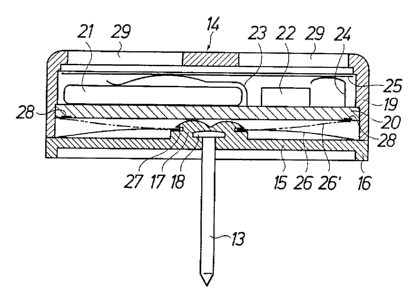Une partie des informations de ce site Web a été fournie par des sources externes. Le gouvernement du Canada n'assume aucune responsabilité concernant la précision, l'actualité ou la fiabilité des informations fournies par les sources externes. Les utilisateurs qui désirent employer cette information devraient consulter directement la source des informations. Le contenu fourni par les sources externes n'est pas assujetti aux exigences sur les langues officielles, la protection des renseignements personnels et l'accessibilité.
L'apparition de différences dans le texte et l'image des Revendications et de l'Abrégé dépend du moment auquel le document est publié. Les textes des Revendications et de l'Abrégé sont affichés :
| (12) Brevet: | (11) CA 2187947 |
|---|---|
| (54) Titre français: | ETIQUETTE D'ALARME ANTIVOL |
| (54) Titre anglais: | ALARM TAG |
| Statut: | Réputé périmé |
| (51) Classification internationale des brevets (CIB): |
|
|---|---|
| (72) Inventeurs : |
|
| (73) Titulaires : |
|
| (71) Demandeurs : |
|
| (74) Agent: | BORDEN LADNER GERVAIS LLP |
| (74) Co-agent: | |
| (45) Délivré: | 2003-07-01 |
| (86) Date de dépôt PCT: | 1995-04-11 |
| (87) Mise à la disponibilité du public: | 1995-10-19 |
| Requête d'examen: | 2001-12-19 |
| Licence disponible: | S.O. |
| (25) Langue des documents déposés: | Anglais |
| Traité de coopération en matière de brevets (PCT): | Oui |
|---|---|
| (86) Numéro de la demande PCT: | PCT/SE1995/000385 |
| (87) Numéro de publication internationale PCT: | WO1995/027959 |
| (85) Entrée nationale: | 1996-10-15 |
| (30) Données de priorité de la demande: | ||||||
|---|---|---|---|---|---|---|
|
Une étiquette d'alarme antivol se compose de deux parties dont l'une (12) est munie d'une épingle (13) fixée sur ladite partie (12) destinée à être placée sur une face d'un produit (11), l'épingle traversant le produit et s'enclenchant sur l'autre partie (10) se présentant contre la face opposée du produit. L'une des parties comporte un circuit déclenchant, soit un dispositif d'alarme situé dans l'autre partie, soit un dispositif d'alarme externe lors de l'entrée ou de la sortie de l'étiquette d'alarme antivol par rapport à un champ externe. En outre, l'une des parties comporte un élément contact (26) actionnant le dispositif d'alarme. Une première position repos de l'élément contact correspond au silence du dispositif d'alarme. Mais par construction, cette première position peut être transformée au moyen de la fixation à épingle en une seconde position repos (26') permettant d'actionner le dispositif d'alarme en cas de tentative de désolidarisation des deux parties de l'étiquette d'alarme antivol.
Alarm tag comprising two parts one
of which (12) is provided with a pin (13)
attached to said one part (12) to be located
on one side of a product (11) with the pin
extending through the product into locking
engagement with the other part (10) located
on the opposite side of the product. One
of these parts has means for activating
an alarm device in said other part and or
an external alarm device by the alarm tag
being carried into or out of an external
field. Furthermore, one part comprises a
contact element (26) operatively related to
said alarm device or a second alarm device,
said contact element normally being in a
first position in which the alarm device is
silent but being constructed to be switched
via the pin attachment to a second position
(26') in order to activate the alarm device
at attempt to separate the two parts of the
alarm tag.
Note : Les revendications sont présentées dans la langue officielle dans laquelle elles ont été soumises.
Note : Les descriptions sont présentées dans la langue officielle dans laquelle elles ont été soumises.

Pour une meilleure compréhension de l'état de la demande ou brevet qui figure sur cette page, la rubrique Mise en garde , et les descriptions de Brevet , États administratifs , Taxes périodiques et Historique des paiements devraient être consultées.
| Titre | Date |
|---|---|
| Date de délivrance prévu | 2003-07-01 |
| (86) Date de dépôt PCT | 1995-04-11 |
| (87) Date de publication PCT | 1995-10-19 |
| (85) Entrée nationale | 1996-10-15 |
| Requête d'examen | 2001-12-19 |
| (45) Délivré | 2003-07-01 |
| Réputé périmé | 2005-04-11 |
Il n'y a pas d'historique d'abandonnement
| Type de taxes | Anniversaire | Échéance | Montant payé | Date payée |
|---|---|---|---|---|
| Le dépôt d'une demande de brevet | 0,00 $ | 1996-10-15 | ||
| Taxe de maintien en état - Demande - nouvelle loi | 2 | 1997-04-11 | 100,00 $ | 1997-04-03 |
| Enregistrement de documents | 0,00 $ | 1997-04-24 | ||
| Taxe de maintien en état - Demande - nouvelle loi | 3 | 1998-04-14 | 100,00 $ | 1998-03-23 |
| Taxe de maintien en état - Demande - nouvelle loi | 4 | 1999-04-12 | 100,00 $ | 1999-03-22 |
| Taxe de maintien en état - Demande - nouvelle loi | 5 | 2000-04-11 | 150,00 $ | 2000-03-13 |
| Enregistrement de documents | 50,00 $ | 2000-09-11 | ||
| Taxe de maintien en état - Demande - nouvelle loi | 6 | 2001-04-11 | 150,00 $ | 2001-03-13 |
| Requête d'examen | 400,00 $ | 2001-12-19 | ||
| Taxe de maintien en état - Demande - nouvelle loi | 7 | 2002-04-11 | 150,00 $ | 2002-03-12 |
| Taxe de maintien en état - Demande - nouvelle loi | 8 | 2003-04-11 | 150,00 $ | 2003-03-21 |
| Taxe finale | 300,00 $ | 2003-04-10 |
Les titulaires actuels et antérieures au dossier sont affichés en ordre alphabétique.
| Titulaires actuels au dossier |
|---|
| MW TRADING (UK) LTD. |
| Titulaires antérieures au dossier |
|---|
| HOLMGREN, BERTIL |
| MW INTERNATIONAL LTD. |